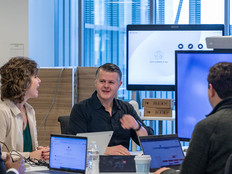Federal agencies are already dabbling in the metaverse, although they generally don’t refer to it that way; they usually say they’re working with augmented or virtual reality instead.
Part of the reason for the differentiation is the popular concept of the metaverse is something far more elaborate: a full simulation of an office space, say, where your personal avatar can speak and interact with other avatars of people who are miles away from your location.
The U.S. Marine Corps is attempting a version of that vision with its Project Tripoli, which will eventually pair Marines conducting live training exercises with other service members working on simulators or with virtual reality equipment.
It’s a way to better connect far-flung forces who have no practical way to train together; Marines training at Twentynine Palms in the California desert, for example, are nearly 200 driving miles away from the nearest naval base in San Diego.
Click the banner below to learn about the benefits of hybrid cloud environments.
“We’re trying to move the ocean toward Twentynine Palms. We haven’t quite figured that out yet,” joked Capt. Garrett Loeffelman, simulation officer for the Marine Corps’ range and training programs division, at the Modern Day Marine conference last year.
In a Project Tripoli scenario, a Marine acting as a joint terminal air controller would be directing both live aircraft and simulated aircraft operated by Marines elsewhere. “Things light up on the real F-35, they light up in the simulator, they light up on the ships,” says Col. Bryan Eovito, commanding officer of the Marine Corps Cyberspace Operations Group.
“We can literally have tens of thousands of Marines and tens of thousands of sensors spread throughout a huge geographic region and come together and interact in a new way.”
Overcoming Hurdles Like Networking and Change Management
A Congressional Research Service report on the metaverse defines the term as an experience rather than a “specific configuration of devices, platforms, applications and services.” The key to a metaverse environment, the report states, is an immersive 3D experience for the user with real-time, reliable network access that works across multiple platforms.
“The networking is, from a technical standpoint, the biggest challenge and the biggest limiter,” says Department of Energy CIO Ann Dunkin. “Our biggest challenge beyond the technology is getting people on board, working in the space successfully.”
Eovito has worked in a virtual meeting space and describes it as “an uncanny valley. The ability to read nonverbal clues — everybody’s emotional intelligence zero in that situation. It’s a lot further along than people think, but it’s not at scale.”
Dunkin personally finds the headsets heavy and uncomfortable, but “when you can create that immersive situation in a way that feels more comfortable, we’ll be heading in that direction. I never want to bet against the industry coming up with something good.”
MORE FROM FEDTECH: The SpaceVerse is Space Force's version of the metaverse.
Cynthia Griggs/U.S. Air Force











